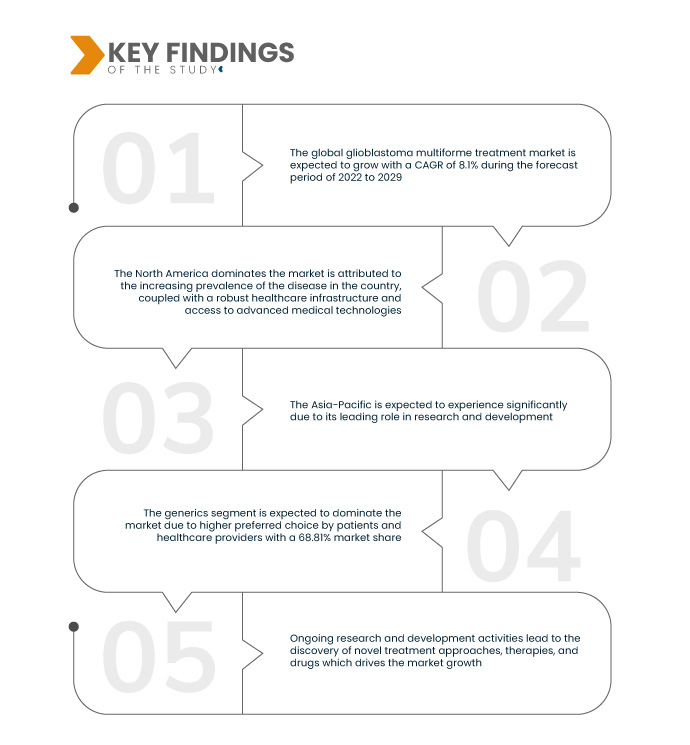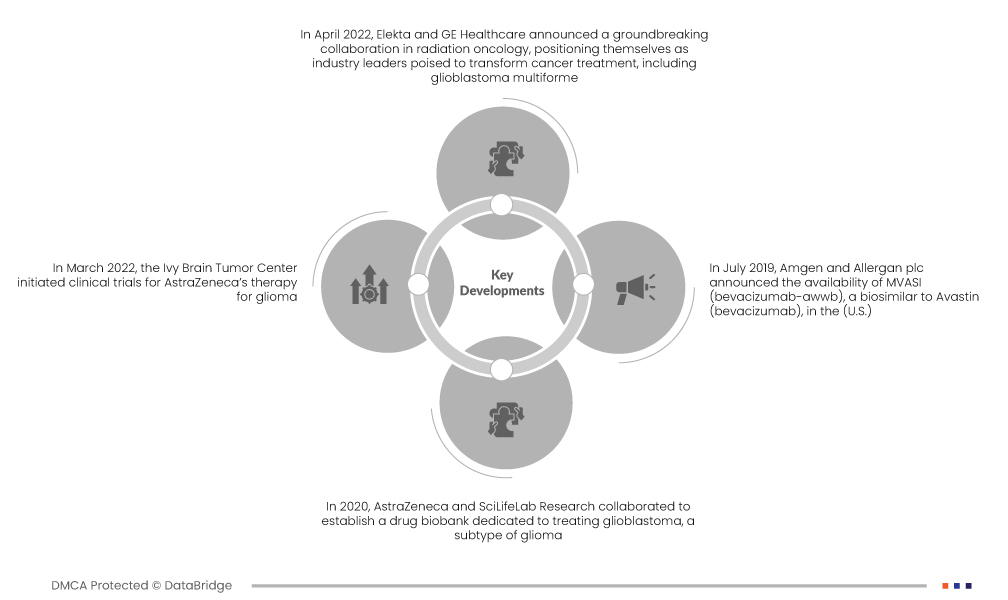Glioblastoma multiforme treatment holds immense importance due to the aggressive nature of the brain cancer. Swift and effective intervention is crucial, as glioblastoma tumors tend to grow rapidly and infiltrate surrounding brain tissue. Treatment aims to alleviate symptoms, improve quality of life, and extend survival. Additionally, advancements in glioblastoma treatments contribute to ongoing research, providing hope for improved outcomes and increased understanding of this complex disease.
Access Full Report @ https://www.databridgemarketresearch.com/reports/global-glioblastoma-multiforme-treatment-market
Data Bridge Market Research analyses the Global Glioblastoma Multiforme Treatment Market will grow at a CAGR of 8.1% during the forecast period of 2022 to 2029. The increasing incidence of glioblastoma multiforme, a highly aggressive form of brain cancer, is a primary driver. Growing awareness, improved diagnostic capabilities, and demographic factors contribute to a higher number of cases, necessitating expanded treatment options.
Key Findings of the Study
Increasing technological advancement is expected to drive the market's growth rate
Technological innovations are pivotal drivers in the glioblastoma multiforme treatment market. These advancements enable the development of more personalized and effective treatment strategies, tailoring interventions to individual patient characteristics. Precision medicine, in particular, allows for a nuanced understanding of the molecular profile of glioblastoma tumors, guiding the selection of targeted therapies. The promise of improved treatment outcomes, coupled with the potential for breakthrough innovations, attracts substantial investments in research and development within the glioblastoma treatment market, fostering a dynamic landscape of innovation and progress.
Report Scope and Market Segmentation
|
Report Metric
|
Details
|
|
Forecast Period
|
2022 to 2029
|
|
Base Year
|
2021
|
|
Historic Years
|
2020 (Customizable to 2014-2019)
|
|
Segments Covered
|
Type (Primary (De Novo), Secondary), Treatment (Surgery, Radiotherapy, Medications), Patient Type (Adult, Geriatric, Child), Drug Type (Generics, Branded), Route of Administration (Parenteral, Oral, Others), End User (Hospitals, Clinics, Home Healthcare, Others), Distribution Channel (Hospital Pharmacy, Retail Pharmacy, Online Pharmacy, Others)
|
|
Countries Covered
|
U.S., Canada, Mexico, Germany, France, Italy U.K., Spain, Russia, Austria, Netherlands, Hungary, Poland, Switzerland, Turkey, Norway, Lithuania, Ireland, Rest of Europe, Japan, China, India, Australia, Singapore, South Korea, Malaysia, Thailand, Indonesia, Philippines, Vietnam, Rest of Asia-Pacific, Brazil, Argentina, Peru, Rest of South America, South Africa, Egypt, Israel, UAE, Rest of Middle East and Africa
|
|
Market Players Covered
|
F. Hoffmann-La Roche AG (Switzerland), Amgen Inc. (U.S.), Merck & Co., Inc. (U.S.), Pfizer Inc. (U.S.), Varian Medical Systems, Inc. (U.S.), ZEISS International (Germany), Amneal Pharmaceuticals LLC (U.S.), Elekta (Sweden), Sun Pharmaceutical Industries Ltd. (India), Teva Pharmaceutical Industries Ltd. (Israel), Eckert & Ziegler (Germany), Accord Healthcare (U.K.), Angiochem (Canada), ANI Pharmaceuticals, Inc. (U.S.), Arbor Pharmaceuticals, LLC. (U.S.), AstraZeneca (U.K.), Cantex Pharmaceuticals, Inc. (U.S.), CELON LABS (India), Diffusion Pharmaceuticals Inc. (U.S.), EnGeneIC Australia, ERC.SA. (Saudi Arabia), Genenta science (Switzerland), Jazz Pharmaceuticals, Inc. (Ireland), Loxo Oncology (U.S.), Novartis AG (Switzerland), VBL THERAPEUTICS (Israel), Viatris Inc. (U.S.), and Zydus Pharmaceuticals, Inc. (India)
|
|
Data Points Covered in the Report
|
In addition to the insights on market scenarios such as market value, growth rate, segmentation, geographical coverage, and major players, the market reports curated by the Data Bridge Market Research also include depth expert analysis, patient epidemiology, pipeline analysis, pricing analysis, and regulatory framework
|
Segment Analysis
The global glioblastoma multiforme treatment market is segmented on the basis of type, treatment, patient type, drug type, route of administration, end user and distribution channel.
- On the basis of type, the glioblastoma multiforme treatment market is segmented into primary (De Novo) and secondary. The primary (De Novo) segment is expected to dominate the market with an 89.67% market share. Early-stage treatments aim to maximize tumor removal and inhibit further growth, contributing to the prominence of the primary treatment approach in managing glioblastoma multiforme
- On the basis of treatment, the glioblastoma multiforme treatment market is segmented into surgery, radiotherapy, and medications. The surgery segment is expected to dominate the market with a 48.95% market share. Surgery helps reduce the tumor burden and facilitates subsequent therapies, such as radiotherapy and medications, by enhancing their effectiveness in managing glioblastoma multiforme
The surgery segment of the treatment segment is expected to dominate the market in the forecast period of 2022 to 2029
The surgery segment of treatment segment is expected to dominate in the glioblastoma multiforme (GBM) treatment market 48.95% market share due to the critical role that surgical intervention plays in the management of this aggressive brain cancer. Glioblastoma multiforme is characterized by its infiltrative nature, making complete surgical resection challenging. However, surgery remains a crucial component of treatment to remove as much of the tumor as possible, alleviating pressure on the surrounding brain tissue and providing a more conducive environment for subsequent therapies.
- On the basis of patient type, the glioblastoma multiforme treatment market is segmented into adult, geriatric and child. The adult segment is expected to dominate the market with 56.97% market share. It dominates due to the higher incidence of glioblastoma in adults compared to geriatric and pediatric populations. Glioblastoma is more commonly diagnosed in adults, particularly those aged 45-75, contributing to a higher demand for treatment interventions in this age group
- On the basis of drug type, the glioblastoma multiforme treatment market is segmented into generics and branded. The generics segment is expected to dominate the market with a 68.81% market share. The affordability makes generics a preferred choice for patients and healthcare providers, driving their higher market share
The generics segment of drug type segment is expected to dominate the market in the forecast period 2022-2029
The generics segment of drug type segment is expected to dominate in the glioblastoma multiforme (GBM) treatment market 68.81% market share can be attributed to several factors. Generics are essentially identical copies of brand-name drugs that have the same active ingredients, dosage, and efficacy as their branded counterparts. In the case of GBM treatment, where the cost of healthcare is a significant concern, generics offer a more cost-effective alternative without compromising therapeutic benefits.
- On the basis of route of administration, the glioblastoma multiforme treatment market is segmented into parenteral, oral, and others. The parenteral segment is expected to dominate the market with the highest CAGR of 10.2%. It dominates the due to the fact that parenteral administration allows for direct and rapid delivery of therapeutic agents into the bloodstream, ensuring quicker and more efficient distribution of drugs to the brain, which is crucial in addressing the aggressive nature of glioblastoma multiforme
- On the basis of end user, the glioblastoma multiforme treatment market is segmented into hospitals, clinics, home healthcare, and others. The hospitals segment is expected to dominate the market with a 58.24% market share. The market can be attributed to its comprehensive healthcare infrastructure, advanced diagnostic capabilities, and the ability to provide integrated and specialized care for complex conditions such as glioblastoma multiforme
- On the basis of distribution type, the glioblastoma multiforme treatment market is segmented into hospital pharmacy, retail pharmacy, online pharmacy, and others. The hospital pharmacy segment is expected to dominate the market with the highest CAGR of 8.7% in the forecast period of 2022 to 2029 due to the critical nature of the disease, as hospitals are primary centers for comprehensive medical care and specialized treatments
Major Players
Data Bridge Market Research recognizes the following companies as the major global glioblastoma multiforme treatment market players in global glioblastoma multiforme treatment market are F. Hoffmann-La Roche AG (Switzerland), Amgen Inc. (U.S.), Merck & Co., Inc. (U.S.), Pfizer Inc. (U.S.), Varian Medical Systems, Inc. (U.S.), ZEISS International (Germany), Amneal Pharmaceuticals LLC (U.S.), Elekta (Sweden)
Market Developments
- In 2022, Elekta and GE Healthcare announced a groundbreaking collaboration in radiation oncology, positioning themselves as industry leaders poised to transform cancer treatment, including glioblastoma multiforme. This strategic partnership aims to provide hospitals with an integrated solution encompassing imaging and treatment for cancer patients undergoing radiation therapy. The initiative reflects a commitment to advancing capabilities in radiation oncology, with potential implications for the precision and efficiency of glioblastoma multiforme treatment. By tailoring solutions to address the unique needs of each cancer center, Elekta and GE Healthcare contribute to the evolution of patient-centric, multidisciplinary approaches, signifying a milestone in the quest for more sophisticated and effective treatments for aggressive forms of cancer
- In 2022, the Ivy Brain Tumor Center initiated clinical trials for AstraZeneca’s therapy for glioma. The trials specifically target the assessment of safety and efficacy in treating patients with recurrent grade IV glioma. This development reflects a commitment to exploring novel therapeutic options for a challenging condition such as glioma, demonstrating the continual efforts to enhance treatment outcomes and provide hope for patients facing recurrent glioblastoma
- In 2020, AstraZeneca and SciLifeLab Research collaborated to establish a drug biobank dedicated to treating glioblastoma, a subtype of glioma. The initiative involved comparing 1,544 drugs with changes in glioblastoma cells, to repurpose existing drugs and discover new treatments. This innovative approach to leveraging a drug biobank underscores the importance of exploring diverse avenues in the pursuit of effective glioblastoma treatments, potentially paving the way for transformative therapies
- In July 2019, Amgen and Allergan plc announced the availability of MVASI (bevacizumab-awwb), a biosimilar to Avastin (bevacizumab), in the (U.S.). This launch marked a significant development, potentially impacting the landscape of glioblastoma treatment. The introduction of biosimilars such as MVASI provides additional options and accessibility to treatment, contributing to the overall advancement of therapeutic options in the U.S. for diseases such as glioblastoma
Regional Analysis
Geographically, the countries covered in the global glioblastoma multiforme treatment market report are U.S., Canada, Mexico, Germany, France, Italy U.K., Spain, Russia, Austria, Netherlands, Hungary, Poland, Switzerland, Turkey, Norway, Lithuania, Ireland, Rest of Europe, Japan, China, India, Australia, Singapore, South Korea, Malaysia, Thailand, Indonesia, Philippines, Vietnam, Rest of Asia-Pacific, Brazil, Argentina, Peru, Rest of South America, South Africa, Egypt, Israel, UAE, Rest of Middle East and Africa
As per Data Bridge Market Research analysis
North America is the dominant region in the global glioblastoma multiforme treatment market during the forecast period 2022-2029
In the North America, the U.S. dominates the glioblastoma multiforme treatment market due to its higher prevalence of glioblastoma multiforme compared to other countries in the region, contributing to increased demand for treatment. Additionally, the U.S. boasts advanced healthcare infrastructure, a robust research ecosystem, and a higher adoption rate of innovative medical technologies, positioning it at the forefront of glioblastoma treatment development and delivery. These factors collectively make the U.S. a key player in driving advancements and dominating the market for glioblastoma multiforme treatments in North America.
Asia-Pacific is estimated to be the fastest-growing region in the global glioblastoma multiforme treatment market for the forecast period 2022-2029
In Asia-Pacific, Japan is expected to experience significant growth during the forecast period in the market due to its investments and advancements in research and development activities. Japan has been at the forefront of medical innovation, with a strong emphasis on cutting-edge technologies and novel treatment approaches. The country's commitment to R&D, coupled with a well-established pharmaceutical and healthcare infrastructure, positions it as a leader in developing and implementing effective treatments for diseases such as glioblastoma multiforme. This leadership role in research and development enhances Japan's capability to drive advancements in glioblastoma treatments, contributing to its anticipated dominance in the Asia-Pacific market.
For more detailed information about the global glioblastoma multiforme treatment market report, click here – https//www.databridgemarketresearch.com/reports/global-glioblastoma-multiforme-treatment-market












